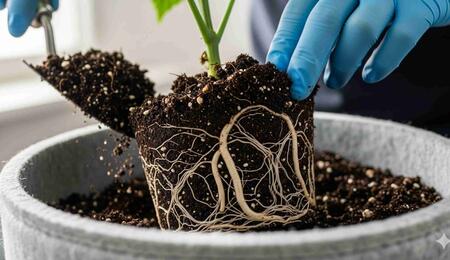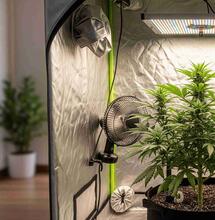Repotting Cannabis Plants and the Importance of Healthy Roots

The roots of a cannabis plant are what dictate how healthy and robust your plants will grow. Cannabis roots require nutrients, air, and space to grow properly. One way to maintain a healthy root system and prevent root-bound plants is by repotting.
In this article, I will cover the process of repotting, its benefits, the frequency of repotting, the types of pots available, and the various kinds of roots and their functions. I will also cover common mistakes to avoid when repotting.
How Often Should You Repot Cannabis Plants?
Whilst you may think that planting your cannabis seeds directly into a large-sized pot is all you need to do as a cannabis grower, you are not wrong. However, increasing the size of the pot as your plants grow has many advantages. Below is a breakdown of the optimal pot size and the recommended frequency for repotting with a new batch of growing medium.
- Seedlings or clones - 1-3 litre pots are ideal for the first 1-3 weeks.
- Early vegetation - 7.5 litre pots are fine for the first 3-6 weeks of the vegetation stage
- Late vegetation stage - 10 - 30 litres are efficient for 6-10 weeks of the vegetation stage.
The Benefits of Repotting
- Cannabis plants will increase in size when repotted
- Roots have more space to expand and grow
- The plants have access to more growing medium
- New root growth occurs after every repot
- Root rot and pathogens are significantly reduced
- Pots can hold more water, nutrients and air
- Big pots result in large-sized and high-yielding plants
- Repotting is easy to do and encourages plant growth
- The risk of root-bound plants is much lower
The Different Types of Pots a Grower Can Use
Whilst many growers prefer to use plastic pots available from the garden centre or local grow shop, a variety of pot types can be used. Each has its own pros and cons, which are explained below.
Plastic Pots
Plastic pots are inexpensive, effective, and readily available. They are available in various colours, including black, white, brown, and green, and can be thin or thick. The advantages of using plastic pots are that they can be washed and reused; however, they can deteriorate over time, losing their structure, particularly when grown outside.
Clay Pots
Clay pots may look great and are ideal for house plants; however, they are heavy, prone to breaking and cracking if knocked over, and typically do not have drainage holes. They don’t provide adequate levels of oxygen roots needed, and are not well-suited for cannabis cultivation, and are expensive to buy compared to standard plastic pots.
Felt Pots
Made from felt fabric, these pots allow air to pass through, which encourages the roots to become pruned and produce a prolific root mass. Felt pots are fantastic at preventing a root-bound structure and also insulate the root zone. The only downside to using fabric pots, based on my experience, is that they can be pretty expensive, and water can escape from the sides when watering your cannabis plants.
Air Pots
Air pots have been designed to allow for the systematic pruning of roots by placing holes in the pots. Air pots will be the most expensive option on this list; however, they produce thick stems and excellent yields. Bottom feeding a cannabis plant using air pots can be a challenge, and water can leak out of the holes on the side. Air pots can be washed and reused, so the initial investment is well worth it over the long term.
3 Mistakes to Avoid When Repotting Plants
#’1: Repotting Autoflowers
Photoperiod cannabis plants can remain in a vegetative state on the basis that they experience an 18-24-hour light cycle. Autoflowering cannabis plants will stay in a vegetative state for 28 days before automatically inducing flowering. Repotting autos can actually do more harm than good, as it may shock and stunt the plants, resulting in lower yields and smaller autoflowering plants.
#2: Using Old Soil When Repotting
A repotted plant loves having more space and nutrients to grow into; however, it always uses a fresh batch of soil or compost. Do not repot your plants into old soil that was previously used, as it may lack nutrients and have a potential buildup of salts. Throw old soil into the compost bin only if you take the steps to inoculate it, thereby recharging the soil's microbial life.
#3: Transplanting Felt Pots
Felt pots do not promote a root-bound shape, so you do not need to worry about the root mass producing a spiral shape at the base of the pot. Although the roots will grow horizontally and grow through the felt, this means that you cannot remove the soil like you would with a plastic pot when turning it upside down. Never tear the roots from the side of the felt fabric; place the fabric pot inside a larger fabric pot when transplanting.
The Different Types of Roots
The Tap Root: The best way to think about the tap root of a plant is to imagine it as the anchor root. Its job is to grow downwards to the bottom of the pot to establish itself. The taproot of a cannabis plant typically grows downward at a depth of 14-16 inches into the soil.
Fibrous Roots: These roots will have a thin appearance and will branch off beneath the stem. Fibrous roots provide a solid structure for a plant to grow, and their role is to absorb water, nutrients and search out for air pockets within the growing medium.
Adventitious Roots: Have you ever noticed that, above the soil surface, the plant produces thick, woody roots? These are known as adventitious roots, and their primary function is to absorb moisture from the air. As they form on non-root tissue, they can be commonly found growing at the base of the stem.
Signs of Healthy Cannabis Roots
- Roots will have a bright white colour
- There will be a large mass of roots
- The aroma of the roots will be earthy and sweet
- The roots will be long and well-established
- Healthy roots produce a fishbone structure
- Water is readily absorbed when inside the medium
Signs of Unhealthy Cannabis Roots
- Roots will be root-bound and compact at the base of the pot
- They may seem yellow or brown
- The roots will be weak and tear apart easily
- There may be a foul odour indicating the presence of pathogens.
- The root mass will be small and poorly established
- A tap root will not have grown deeply into the pot
3 Ways to Inoculate the Root Zone
Big roots mean big fruits, and the more help a cannabis plant’s root mass can get, the better! One way to ensure that your plant’s roots are as healthy and strong as possible is to inoculate them and introduce beneficial microorganisms. Below is a breakdown of the three different ways you can enhance the soil food web and enhance root health and defence against pathogens.
Mycorrhizal Fungi
A beneficial plant fungus that forms symbiosis with the roots of a cannabis plant. Mycorrhizal fungi attach themselves to the root tissue, significantly expanding the root mass, enhancing nutrient uptake and availability, and helping to fight off pathogens such as root rot. Different types of mycorrhizal fungi that can be used are Endomycorrhizae, Arbuscular Mycorrhizal Fungi, AM and Ectomycorrhizae.
Probiotic Bacteria
These are helpful bacteria that accelerate the rate of compost within the growing medium, resulting in a quicker conversion of nutrients for the plants. The different types of probiotic bacteria beneficial for cannabis include Bacillus, Pseudomonas, Azotobacter, Rhizobium, Enterobacteriales, and Paenibacillus.
Aerated Compost Tea
Aerated teas are an excellent way to supercharge an old or existing growing medium, as they provide a tonic rich in beneficial bacteria and fungi. All you need is a bucket of unchlorinated water, an air pump, and a source of good-quality compost or worm castings. Allow the water to brew for at least 24 hours.
The Benefits of Inoculating Cannabis Plants
- The soil food web productivity is enhanced
- The roots have the highest amount of resistance to pathogens.
- Soil can be reused after harvesting
- Roots become resilient to drought conditions
- Pathogens will not be able to survive in the soil
Enzymes for Healthy Roots
Enzymes work by breaking down organic matter, making readily available nutrients more accessible. They also promote a healthy and clean white colour and lower the risk of root rot. When adding enzymes to your nutrient solution, not only does the taste of your crop improve, but plants can also utilise the nutrients more easily and efficiently than without them.



